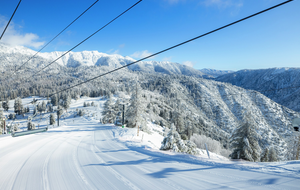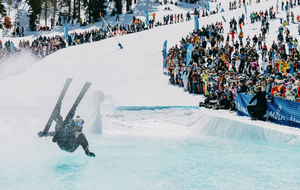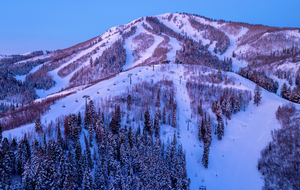Ski Equipment Guide: Choosing The Right Gear For You
Whether you’re new to the bunny hill or ready to tackle any terrain, having the right ski equipment keeps you safe while having fun on the slopes. We’ve put together this guide to help you choose the right skis and gear for your skill level.
What ski equipment is the best (for you)?
It’s about more than just having fancy skis. Equipment is designed differently depending on your ability and control over the skis.
Choosing the right skis
The most important factor in choosing skis is to consider the type of terrain you’ll be on. Will you be on a groomed mountain with packed snow, or off the trails? Different skis will perform better in different conditions.
Groomed Terrain: Track skis are great for groomed terrain and trails.
Groomed/Powder Mix: Go with the versatile, wider all-mountain skis.
Backcountry: Make your own tracks off the trail with freeride skis.
Racing: For downhill and slalom racing, look for narrow race skis.
Snowpark: Choose freestyle skis for doing tricks in the snowpark.
Consider the design of the ski:
Rocker, also known as reverse-camber or early rise, has a flat bottom while the tip and tail of the ski bend up off the snow. More rocker means more maneuverability, easier carving, and more flotation, helping you stay on top of soft, deep snow. Beginning skiers will improve more quickly and have more fun with just a little rocker.
The camber is the opposite of rocker; it is the upward flexing arc of the bottom of the ski. This makes for easier handling, turning, and stability for the skier. This is seen on traditional skis and is great for skiing on groomed or hardpacked snow.

As mentioned, the width of the ski is also important to consider. Narrow skis are meant for groomed conditions and hardpacked snow, because the smoother surface makes it easier for carving turns. Wider skis provide more stability and are better for powder or deep snow.
Ski length is also important. When standing up, your skis should come somewhere between your chin and the top of your head. The shorter the ski, the more handling you’ll have; the longer the ski, the more stability.
Ski bindings
The bindings are what connects you (and your boots) to the ski. You have the option to choose integrated bindings or buy the bindings separately. Integrated bindings are designed specifically for that pair of skis and come already installed. They are not only convenient but also tend to flex more naturally. Advanced skiers may prefer to purchase bindings separately to meet their specific needs. If you choose to do this, make sure they are installed and adjusted by a professional.
Ski bindings not only hold your skis onto your boots – they are designed to release the skis in a crash! Your release settings are based on your height, weight, age, and ability. These settings should only be adjusted by a professional.
Ski boots
Ski boots consist of a hard outer shell and a soft inner layer. Some boots have moldable inner layers for a more custom fit.
Boots range in flexibility and the “flex index” is correlated to your ability level. The higher the flex index number, the stiffer the boot, and the more advanced you should be as a skier. For beginners, a soft flex (85 for men, 75 for women) will be best. For intermediate skiers, or beginners who expect to progress quickly, a medium flex (90 – 110 for men, 80 – 95 for women) will be great for those steeper terrains. More advanced and expert skiers will want a stiff flex boot (>115 for men, >100 for women). These stiff flex boots are designed for speed and steep terrain.
Ski poles
For beginners, ski poles are not necessary, but can come in handy. Instead of having to skate on your skis to head back to the lodge or to the next lift, you can use your poles to push you along. For more advanced skiers, poles can help with balance or quick turns on moguls. You want your poles to be strong enough to support being planted during turns, but light enough that you aren’t tired from holding them all day.
To make sure your poles are the right length: stand in your ski boots and hold your poles. Your elbows should be at a 90-degree angle. Make sure the nylon wrist strap is adjusted comfortably to your wrist.
Goggles
Goggles can come in quite handy. With the reflection of the sun off the snow, UV rays can be harmful to eyes, nevermind the falling snow or debris. Make sure the goggles you choose are compatible with your helmet and are snug, but not too tight.
Helmet
Whether you’re a beginner or an expert, everyone needs a helmet. Not only do they protect your head in case of a fall or from sharp objects, but they help keep you warm all day. Make sure your helmet meets the U.S. standard for snow helmet certification, the ASTM F2040, or the European certification, CE EN1077. Your helmet should have a hard outer shell and a foam inner liner. Helmets should always be replaced after a serious fall, since they may not provide as much protection once they have been damaged.
Try on a variety of helmets to see what feels comfortable and fits with your goggles; there shouldn’t be a gap between your goggles and helmet. Helmets can have a variety of features like camera mounts for a GoPro, built-in speakers, and adjustable vents. Choose what feels right for you and will keep you safe.
How much does all this ski equipment cost?
Unfortunately, all this equipment and gear that is needed can be pricey; a quality pair of skis alone can cost several hundred dollars, nevermind bindings, boots, and all the rest. It can also be a huge struggle and cost to pack up and travel with your gear for every trip to a new mountain. Multiply this by the number of people traveling, like your partner and children, and you’ve racked up a huge cost before even buying the lift tickets.
Instead of spending potentially thousands of dollars on ski gear that will soon be outdated, Ski Butlers has your solution. We have all the latest and greatest gear at locations across North America and Europe. Our team brings the equipment to you, meaning you don’t have to spend money to buy, pack, and lug it all around.
For less than the price of a new pair of skis, you can have high-performance skis, boots, a helmet, and goggles delivered to your hotel room, personally fitted for you and rented for four days in Park City. Use our price calculator to get an estimate of how much it will cost for you and your group.
What type of ski equipment does Ski Butlers offer?
While some people may be happy sticking to one condition, it can be fun to experience different terrains. Maybe you want to try a groomed mountain at Snowmass, but go off-trail in Tahoe; you shouldn’t have to buy a different pair of skis for each trip. Ski Butlers has you covered.
We have rental packages for first-timers, kids, intermediate skiers, and expert skiers. Each of these levels has a variety of skis with a range of rocker and sidecut for different terrains. For example, a junior skier could choose a Rossignol Smash 7 with more rocker for all snow, or a Rossignol Hero with less rocker for on-trail skiing along with performance boots all for about $50 a day.
On the other hand, an advanced skier can choose from a variety of high-performance skis. The Rossignol Experience 80 has less rocker for on-trail skiing, while the Rossignol Soul 7 has more rocker for back trails. Rent high-performance skis for about $65 a day. Make a reservation here.
How does it work?
Our ski equipment rentals are great for individuals and families alike, whether you are all first-time skiers or on your annual ski trip. Our Ski Butlers team brings the equipment right to where you are staying. We bring a variety of boot sizes to ensure a proper fit and the right gear for your skill level. If you have any issues, or want to switch out gear, just call us and we will be there with new equipment in less than 45 minutes, guaranteed.
Once you’re done, we come pick it up from you, so you can get on your way without the extra hassle. Find answers to common questions about Ski Butlers here.
Ski gear checklist
Heading to the mountain? Make sure you have everything you need from the top down.
-
Helmet
No excuses. -
Goggles
Protect your eyes from both UV rays and snow or debris. -
Layers
Think thermals and fleece that can be removed or layered up. -
Jacket
Choose something that’s waterproof and has pockets. -
Gloves
Make sure they are waterproof and made for freezing temperatures. -
Poles
Pick the right size – remember your elbow should be at a 90º angle. -
Snow pants
Waterproof, insulated pants are the way to go. -
Socks
Tall socks will prevent bunching in your boots. -
Ski Boots
Choose the right flex index for your skill level. -
Skis & Bindings
Make sure these are right for your skill level too.


